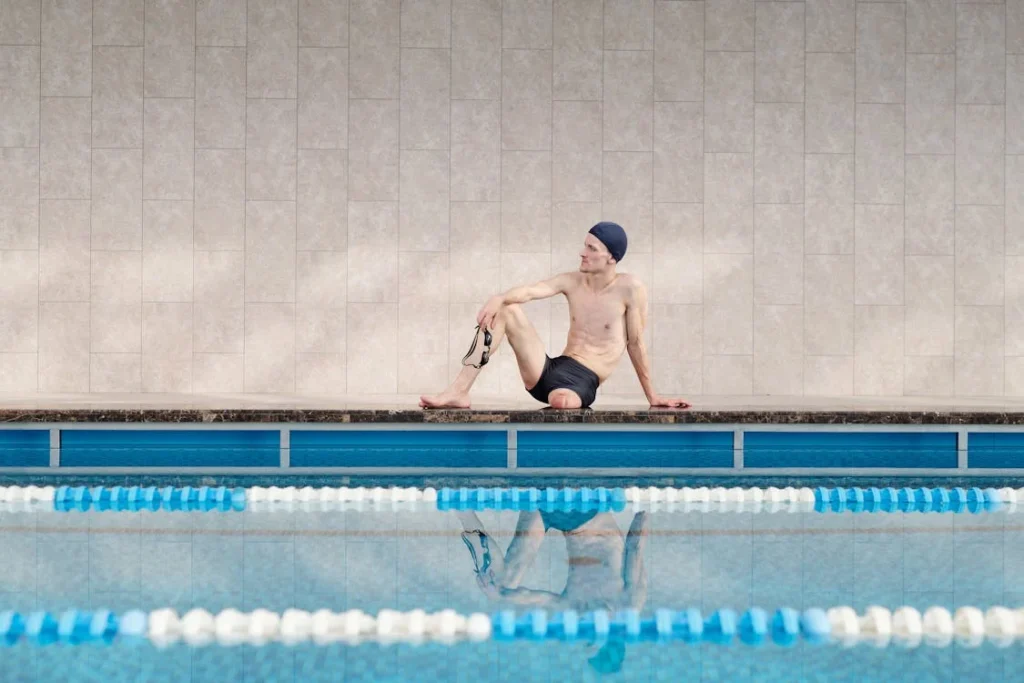After losing a limb, the journey toward using a prosthetic doesn’t start with choosing the device. It begins with preparing your body to accept it. One of the most important steps in this process is stump desensitization. This simple but powerful practice helps your residual limb become less sensitive to touch, pressure, and movement—making it more comfortable and natural to wear a prosthesis later on.
At first, even light contact with the stump can feel strange or painful. Everyday things like fabric, air, or even a soft towel may cause discomfort. This happens because your skin and nerves are reacting to a major change. If left unaddressed, these sensations can get worse. They can lead to pain, emotional stress, and a poor prosthetic fit. That’s where desensitization comes in.
Stump desensitization is not a fancy or high-tech process. It uses basic, hands-on methods to help your skin, nerves, and brain adjust to new sensations. It trains your body to get used to touch again—step by step, day by day. Done right, it can reduce pain, improve prosthetic comfort, and help you feel more in control of your recovery.

Why Desensitization Matters Before Using a Prosthesis
Preparing the Skin and Nerves for Daily Use
After amputation, the skin and nerves around your stump become more sensitive. This is completely normal. Your body is responding to the trauma and the healing process.
But if the area stays too sensitive, it becomes hard to tolerate pressure or contact from clothing, bedsheets, or later—a prosthetic socket.
That’s where stump desensitization helps. It slowly trains the skin and nerve endings to become less reactive. By exposing your stump to gentle, controlled touch, your brain starts to learn that these sensations are not dangerous.
Over time, what once felt sharp or painful will begin to feel neutral or even relaxing.
Without this preparation, the first time you wear a prosthetic socket can be overwhelming. The fit may feel too tight, even if it’s correct. The material might cause soreness, not because it’s bad, but because your skin hasn’t adjusted.
Desensitization builds tolerance, reduces discomfort, and makes that first fitting feel much smoother.
Building a Healthier Relationship With the Stump
Beyond the physical benefits, desensitization also plays a mental role. Right after surgery, many people avoid touching their stump. It might feel strange. Some are scared of hurting it, while others don’t want to face how different it looks. But avoidance can make things worse over time.
When you take the time to touch and care for your stump gently, you build a connection with it. You start to accept it as part of your body again.
That shift—mentally and emotionally—can help a lot when you’re learning to use a prosthetic. You’ll move with more confidence and less fear. You’ll also notice signs of irritation or swelling faster because you’re not avoiding the area.
Desensitization gives you that hands-on experience. It makes the stump feel less like a wound and more like a part of you again.
When to Start Stump Desensitization
Timing Is Everything
You should not start desensitization right after surgery. The stump needs to heal first. If the skin is still open or if there’s any sign of infection, this process must wait. Touching the area too soon can reopen the wound or spread bacteria.
Usually, your surgeon or therapist will tell you when it’s safe to begin. For most people, this is within a few weeks after the surgery, once the wound is closed and the stitches have been removed. At this point, the area may still be tender—but that’s exactly when desensitization starts to become useful.
The goal is not to rush but to start early enough that the skin and nerves can adjust before you begin prosthetic training. The sooner your body adapts, the easier it will be to tolerate the pressure, friction, and contact that come with using a socket every day.
Listen to Your Therapist and Body
Your rehab team will guide you, but your body also gives signals. If something hurts too much, it’s okay to pause. Desensitization should never cause sharp pain or burning. Mild discomfort is fine, but if it becomes too intense, it means your body needs more time.
Some days will feel easier than others. That’s completely normal. The key is to stay consistent. Even five to ten minutes a few times a day can make a real difference. The results come from small, regular efforts—not from pushing too hard.
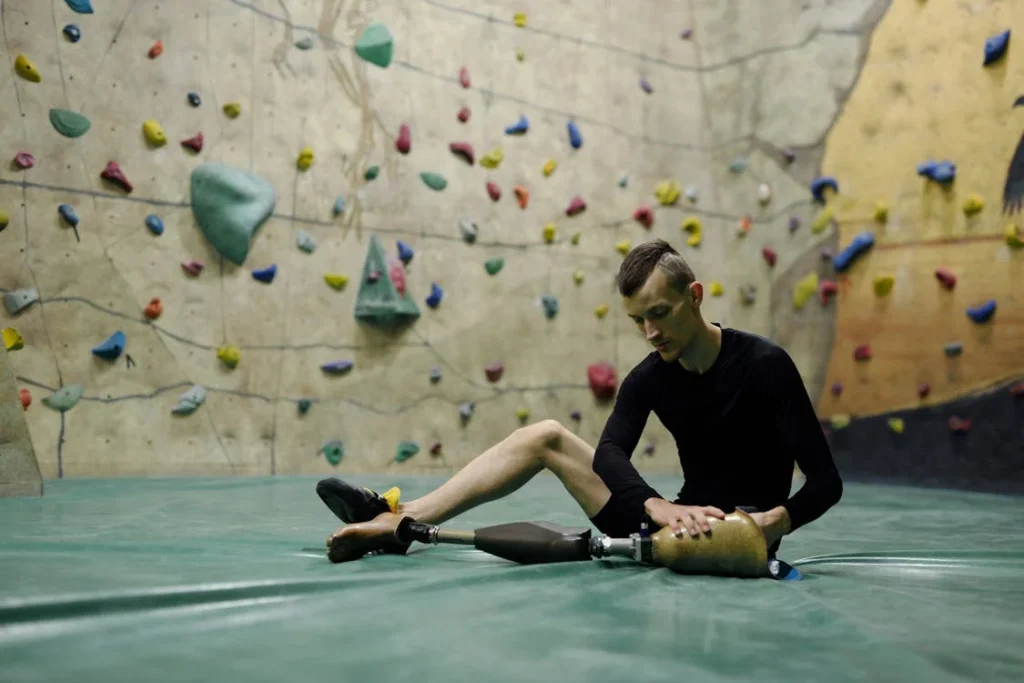
What Happens If You Skip Desensitization
Increased Risk of Socket Discomfort
One of the biggest problems people face when they skip desensitization is a poor prosthetic fit. Even with a well-designed socket, the stump can feel sore, itchy, or raw.
That discomfort makes people wear their prosthetic less often. They might avoid walking or standing because it doesn’t feel right. This leads to delays in recovery, weaker muscles, and lower confidence.
What starts as a small issue becomes a cycle of setbacks. The less you wear the prosthetic, the harder it is to adjust to it. The harder it is to adjust, the more you avoid it. Desensitization helps break that cycle before it begins.
Mental and Emotional Setbacks
Skipping this part of therapy also affects your mindset. If the first experience with the prosthetic is painful, it’s easy to become discouraged. Some people feel like they’re failing or that something is wrong with them. They might lose trust in the process or pull away from therapy.
On the other hand, when desensitization is done well, that first fitting becomes a positive experience. It builds momentum. You feel encouraged, stronger, and more ready to keep going.
That emotional boost is just as important as the physical benefits. Confidence plays a huge role in long-term prosthetic success, and desensitization helps build that foundation.
How Stump Desensitization Actually Works
Teaching the Brain to Feel Differently
After amputation, your brain still holds a map of your missing limb. It remembers how the skin felt, how the muscles moved, and what pressure was like.
But now, those signals are mixed. The nerve endings in your stump are still active, but they’re not getting the same feedback as before.
This mismatch can lead to unusual sensations—like itching, tingling, or even pain in the part of the limb that’s no longer there. These are called phantom sensations. They’re very common and not dangerous, but they can feel strange or upsetting.
Desensitization helps your brain re-learn how to feel. When you gently touch or massage the stump in a regular, controlled way, you’re giving the brain new, clear signals.
Over time, it starts to understand that this new part of your body—the residual limb—is safe to touch. It stops overreacting to contact. That’s why simple activities, done repeatedly and calmly, can make a big impact.
You’re not just training your skin. You’re helping your brain calm down and respond normally again.
Helping the Skin and Soft Tissue Adjust
The skin around the stump also goes through changes. At first, it may be thin, fragile, or irritated easily. The tissue underneath might swell or hold onto fluid. Rubbing, tapping, or moving the skin gently helps improve blood flow. It makes the area stronger and more resilient.
This is important for prosthetic wear. A good socket fit depends on stable, healthy skin that can handle pressure without breaking down. When the tissue is prepared through desensitization, you lower the risk of blisters, bruises, and friction burns.
What feels like a simple routine of light touch is actually preparing the skin to handle a whole new level of activity later.

Key Techniques Used in Desensitization
Gentle Touch and Massage
The most basic method is simply using your hand to stroke or tap the skin. Start with very light pressure. Use clean fingers or a soft cloth. You can gently rub the area in circles, up and down, or side to side.
As your comfort improves, slowly increase the pressure. You can even tap with your fingertips to stimulate the nerve endings.
The goal here isn’t to rub hard—it’s to create a steady stream of touch so that your brain and skin start seeing it as normal.
Doing this daily, even for a few minutes, can help your limb become more tolerant of contact. It also builds your own confidence in caring for your body after surgery.
Using Different Textures
After getting used to your own hand or a soft towel, you can try using different textures. A cotton cloth, fleece, sponge, or even a soft brush works well.
These textures stimulate different nerves and teach the skin how to handle variety. Start with the softest materials, and as your comfort grows, move on to slightly rougher ones.
There’s no rush. Each material adds a new layer of learning for your nerves. If anything feels too sharp or painful, stop and return to a gentler surface. This process should be slow, steady, and guided by how your body reacts.
You’re not just building tolerance—you’re teaching your skin to be flexible.
Vibration and Tapping
Some therapists recommend using a small hand-held massager or vibration device once the skin is fully healed. These tools send deeper signals through the soft tissue and nerves. The vibration can be soothing, and it reaches parts of the limb that rubbing can’t.
Tapping with your fingertips or a soft object, like a rubber ball, can also help. You can do this while watching TV or relaxing. It doesn’t need to be formal or intense. The key is consistency.
These small, repetitive actions add up. They make your stump more ready for the feel and fit of a prosthetic socket.
Making Desensitization Part of Daily Life
Choosing the Right Time
Desensitization doesn’t need a special appointment or clinic. You can do it at home, at your own pace. The best time is when you’re calm, not rushed, and can focus on how your body feels.
Some people prefer mornings, as it helps set a comfortable tone for the day. Others find it relaxing before bed.
You might also want to time it before therapy sessions, as a way to prepare the limb for exercises or weight-bearing.
It’s not about how long you do it. Even five to ten minutes, two to three times a day, can bring great results over a few weeks. What matters most is staying consistent. It’s the regular practice that changes how the nerves respond—not the intensity.
Creating a Comfortable Space
To make this a habit, set up a spot in your home where you feel safe and relaxed. Keep your supplies nearby—a towel, a soft cloth, maybe a mirror if you’re doing visual feedback techniques. If you like, play soft music or take a few deep breaths before starting.
This routine should feel like self-care, not a chore. The more peaceful the environment, the more your nervous system can relax. That helps the skin and brain accept the stimulation more easily.
Desensitization is not just physical. It’s emotional, too. Treat it like a way to connect with your healing body, not just another task to check off.
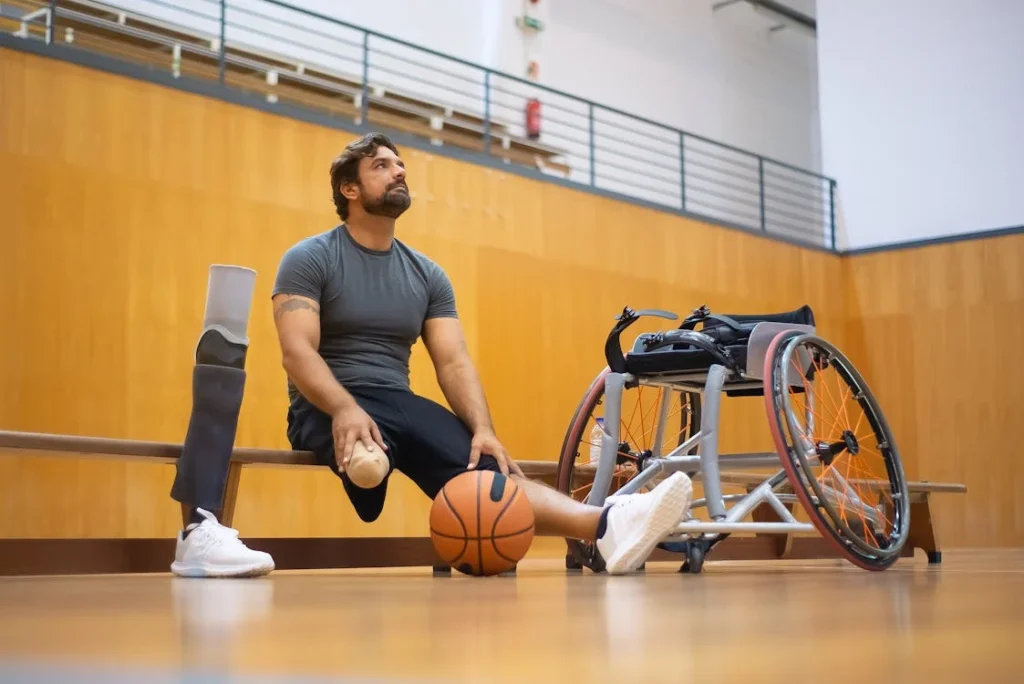
Common Challenges During Desensitization and How to Handle Them
Dealing With Discomfort in the Early Stages
In the beginning, stump desensitization might not feel pleasant. For many people, even the softest touch can feel irritating or “too much.” That doesn’t mean you’re doing something wrong. It simply means your nerves are still healing, and your brain is reacting strongly to the new input.
The key is to start very small. You don’t need to spend a long time or apply any pressure. Even placing a soft cloth gently over the stump without moving it can be a starting point. As that feels more comfortable, you can move forward with light strokes or tapping.
Pushing through pain is not the goal. Desensitization should feel like mild discomfort at most—not sharp pain. If you go too fast, you may become discouraged or even cause irritation.
Always listen to your body, and take a break when needed. Over time, the discomfort usually fades as your nerves settle down and your skin toughens up.
Managing Phantom Sensations During Touch
Sometimes, desensitization can stir up phantom sensations—the feeling that your missing limb is still there or that it’s hurting, itching, or cramping. These feelings are real, and they can be confusing.
Instead of avoiding the area, try using the desensitization routine as a way to gently guide your brain back to reality. You can even say out loud what you’re doing: “I’m rubbing my stump. It’s safe. It feels soft.” These simple affirmations, combined with touch, help your brain build a new map of your body.
Mirror therapy can also be helpful in this case. Looking at your intact limb in the mirror while you stimulate the stump with soft textures can trick the brain into feeling more balanced. It’s like giving the brain a new visual and sensory story to follow.
If the phantom pain becomes too much to handle, don’t hesitate to tell your therapist. There are ways to adjust your routine or combine it with other methods to help ease the discomfort.
Involving Your Support System in the Process
Getting Help From Family or Caregivers
You don’t have to do desensitization alone. In fact, having a loved one involved can make it easier—especially if you feel nervous about touching the stump yourself in the early days.
A caregiver can help by gently performing the techniques under your guidance. It also gives them a chance to be part of your recovery in a meaningful way.
Before they begin, it’s helpful to explain what you’re comfortable with and how you’d like to be touched. Start with short sessions and always check in during the process. If something feels off, let them know.
Having someone by your side can also help with motivation. On days when you’re tired or emotionally low, they can remind you why this matters and offer encouragement. Just knowing someone is there makes it easier to stay on track.
Sharing Progress With Your Therapy Team
As you go through the desensitization journey, keep your therapist updated. If something starts working well, they’ll want to know so they can build on it. If something doesn’t feel right, they can help you adjust your technique.
You can even bring your tools—cloths, brushes, or rollers—to a therapy session. This allows your therapist to check how you’re using them and suggest better ways if needed.
Sharing your progress makes the journey more collaborative. You’ll feel more supported, and your care plan will stay on the right path.
Open communication ensures you’re not guessing what to do next. You’re learning, practicing, and improving as a team.

Signs That Desensitization Is Working
Improved Tolerance to Daily Activities
One of the first signs that desensitization is working is when normal activities start to feel more comfortable. Maybe you notice that your clothes no longer bother your stump. Or maybe you can rest your limb on a pillow without discomfort. These are small but powerful wins.
You might also find that you’re touching your stump more without even thinking about it. That’s a sign your brain no longer sees the area as overly sensitive or off-limits. You’re starting to reintegrate it as part of your daily body awareness.
Everyday comfort is a major milestone. It shows that your body and brain are working together again—and that’s exactly what desensitization is meant to do.
Better Prosthetic Tolerance
When the time comes to be fitted for a prosthetic, all your desensitization work pays off. The socket will still feel new, but it won’t feel overwhelming. You’ll be able to wear it for longer periods, with fewer complaints about pressure or rubbing.
Your therapist or prosthetist will notice, too. They’ll see fewer red marks on your skin. You’ll move more freely and with more confidence. These early victories make the next phase of rehab—prosthetic training—more successful and enjoyable.
In the long run, a well-tolerated prosthetic leads to better mobility, more independence, and a higher quality of life. That’s why this preparation phase is so important.
Combining Desensitization With Other Rehab Activities
Strengthening While Desensitizing
Desensitization works best when it’s part of a complete rehabilitation plan. While you’re working on reducing sensitivity, it’s also a good time to begin gentle strengthening exercises.
These exercises help build muscle around the stump and prepare your body to support a prosthetic limb.
For example, you might do light leg raises, stretches, or core exercises that don’t strain the stump. As the sensitivity decreases, you’ll feel more comfortable moving and placing light pressure on the limb.
This smooth transition from touch tolerance to movement tolerance is a key milestone in your recovery.
The stronger your muscles and more resilient your skin, the better your prosthetic will fit and function. So even though desensitization feels like a small task, it opens the door to much larger gains.
Posture and Balance Work
Another area that connects with desensitization is balance training. After an amputation, your sense of balance changes. You may lean more on one side or feel uncertain when standing.
As your stump becomes less sensitive and more stable, it’s easier to practice standing posture and weight shifting.
Your therapist might guide you through simple balance activities, such as sitting without support, standing with assistance, or transferring weight side to side. These actions help your brain and body re-learn symmetry.
The connection here is subtle but important. When your stump is overly sensitive, balance work is harder and sometimes painful. But as desensitization improves comfort, these movements become easier and more natural. The body can begin working as a whole again.
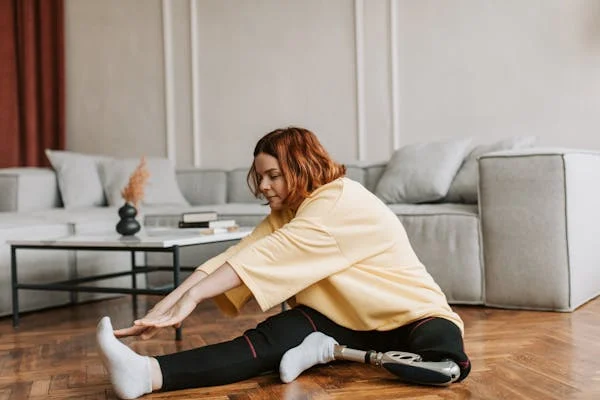
Personalizing Your Desensitization Routine
Understanding Your Own Body’s Needs
No two people experience stump sensitivity in the same way. Some feel intense tingling, others feel burning, while some might feel numbness or buzzing. Because of this, your desensitization routine should be personalized to match your symptoms and your tolerance.
For example, if you’re experiencing sharp pain with every touch, starting with very light fabric or simply holding the stump with both hands may be enough for the first few days.
If your stump is mostly numb, using textures with more variety and vibration might help stimulate the nerves more effectively.
There’s no one-size-fits-all approach. You don’t need fancy equipment or tools. What you need is attention—paying close attention to how your stump reacts, adjusting your technique, and keeping a regular rhythm.
Adjusting Based on Progress
Your routine shouldn’t stay the same forever. As you get used to certain materials or sensations, slowly change them. You might add more pressure, switch to a rougher texture, or move the cloth in a different direction.
The body thrives on variety. Keeping the nerve endings guessing helps them continue adjusting and prevents them from getting stuck in one pattern.
But always make changes gradually. If something that was once comfortable starts to hurt again, step back to the last stage that felt good. There’s no shame in taking a pause or repeating a previous step. Healing is not a straight line—it’s a cycle of progress, rest, and re-adjustment.
Tips to Stay Consistent Without Burnout
Making It a Daily Ritual
Staying consistent with desensitization can be difficult, especially when progress feels slow. One way to keep going is to make it part of something you already do. Pair it with another daily habit, like brushing your teeth, having your morning tea, or watching a favorite TV show.
This makes the routine feel less like a medical task and more like part of your everyday life. It becomes a ritual—not just a chore.
You can also keep a small notebook or calendar nearby. Just jotting down, “Did my stump work today” can help track your effort. Seeing that streak grow—even if the results aren’t dramatic yet—can motivate you to keep it up.
Being Patient With Small Wins
Desensitization doesn’t usually bring instant change. But small signs—like being able to wear a sock comfortably or rest your stump on a soft cushion—are proof that it’s working.
A lot of people give up because they expect the stump to feel completely normal in just a few days. That’s not how nerves work. They heal and adjust slowly, through repeated exposure and gentle pressure.
If you celebrate each small improvement, you’ll build momentum. You’ll also be less likely to quit when things feel slow. Every little gain matters.
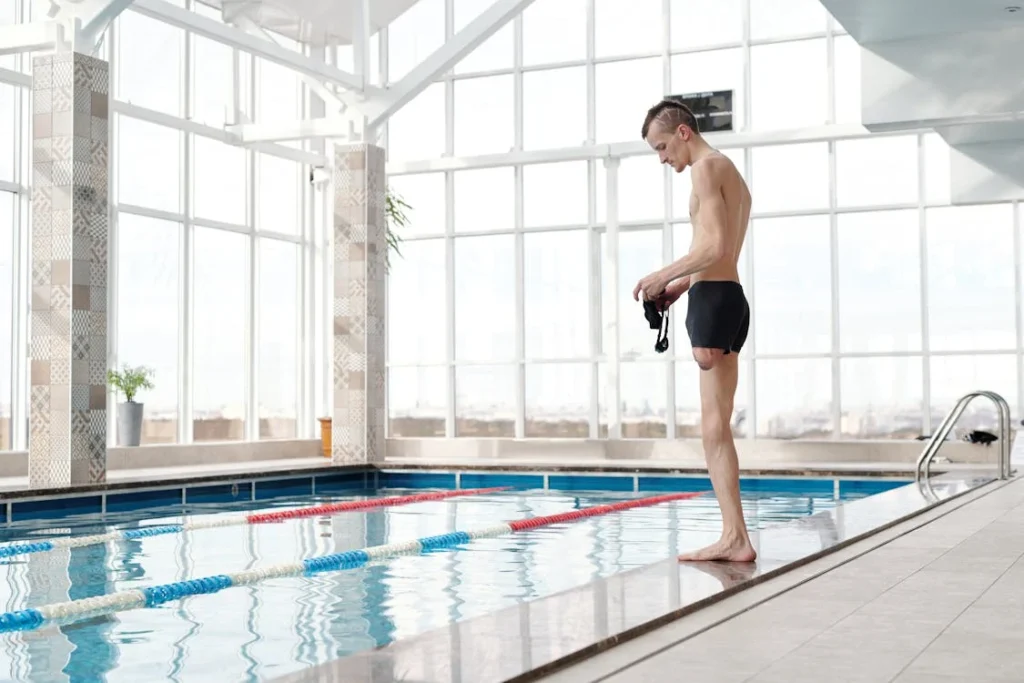
Emotional Benefits of Desensitization
Regaining a Sense of Control
One of the hardest parts of limb loss is feeling like you’ve lost control over your body. Your routines change, your mobility is limited, and your independence may feel out of reach. Desensitization offers a way to take some of that control back.
It’s something you can do on your own, in your own time, and at your own pace. You don’t have to wait for a doctor or schedule a clinic visit. You just need your hands, a soft cloth, and a few minutes of calm.
That simple act—choosing to touch, massage, and care for your stump—rebuilds confidence. It shifts the focus from loss to healing. It reminds you that you are not passive in this journey. You are an active part of it.
Reconnecting With Your Body
After an amputation, some people disconnect from the part of their body that’s changed. They may avoid looking at it or touching it. They may feel anger, sadness, or shame. This emotional distance makes recovery harder.
Desensitization brings you back into contact—not just physically, but emotionally. As the touch becomes more comfortable, so does the idea of accepting the stump as part of you. This emotional shift is just as important as the physical change.
You start to trust your body again. You begin to feel whole—not broken. That mental strength supports everything else in your rehab journey.
Preparing for Prosthetic Fitment After Desensitization
Knowing When You’re Ready
As you continue desensitization over several weeks, your limb will slowly feel more comfortable during contact. You’ll start to notice that basic activities—like touching the stump, resting it on a surface, or pulling on a shrinker sock—don’t bother you like they used to. This is a great sign.
It means your skin, soft tissue, and nerves are adapting. You’re building the foundation for wearing a prosthesis without unnecessary irritation or pain. When your therapist sees these changes, they’ll begin planning for your first prosthetic fitting.
This step is exciting, but don’t rush into it. Even if you’re eager to get your prosthesis, it’s better to wait until your stump is truly ready. If it’s still very sensitive, you might find the socket uncomfortable.
That discomfort could lead to avoiding the device, and eventually a longer road to walking confidently.
Let your body and your rehab team decide when it’s time. Trust the process—especially if you’ve put in the work through desensitization. The payoff is a smoother fitting experience and less need for repeated adjustments.
What to Expect From the First Fitting
When your prosthetic socket is made, it’s custom-molded to your stump. That means it fits snugly—on purpose. It should feel supportive, but not painful.
Thanks to desensitization, your skin and nerves will already be used to pressure. That makes this first session easier to handle, both physically and mentally.
You may wear the prosthesis for short periods at first, gradually increasing the time as your tolerance grows. And yes, your stump may still feel a little awkward in the beginning. That’s normal. But because you’ve trained your body through daily touch and exposure, you’ll adjust more quickly.
Desensitization doesn’t guarantee perfection. But it gives you a serious advantage: fewer surprises, faster adaptation, and more comfort from day one.
Conclusion
Desensitization might seem like a simple task. A few minutes of touch here, some gentle tapping there. But its impact is huge. What you’re really doing is reintroducing your body to itself. You’re calming down overactive nerves, softening tight skin, and preparing your limb to become part of a prosthetic system that will carry you into the next chapter of your life.
This process is quiet, steady, and often invisible to others. But inside your body, real change is happening. You’re telling your nerves: this is okay. You’re telling your brain: I’m safe. You’re telling yourself: I’m ready.
And over time, those small touches create a big shift—not just in how you feel, but in how you move, how you think, and how you live.
If you take nothing else from this article, take this: desensitization is a gift you give to your future self. It makes your prosthetic journey easier, smoother, and more empowering. It’s the first act of trust in your body’s ability to adapt—and thrive.
So start where you are. Go gently. Stay consistent. And know that every small effort brings you one step closer to comfort, confidence, and independence.



